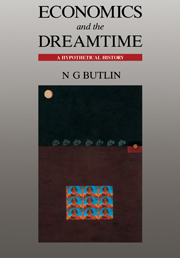Book contents
- Frontmatter
- Contents
- Preface
- Acknowledgements
- Figures
- Maps
- Tables
- Introduction
- Part I The palaeoeconomic history of Aboriginal migration
- Part II Development, structure and function of Aboriginal economy
- 7 Introduction
- 8 The process of early settlement
- 9 Variety in the precontact Aboriginal economy
- 10 The nature and function of Aboriginal economy
- 11 Dynamic elements in the Aboriginal economy
- Part III Disease, economics and demography
- Part IV The establishment of a bridgehead economy: 1788–1810
- Part V The takeover process: 1788–1850
- Bibliography
- Appendix 1 Preliminary model/checklist of Aboriginal migration to Australia
- Appendix 2 NOAA depth contour maps
- Index
9 - Variety in the precontact Aboriginal economy
Published online by Cambridge University Press: 06 July 2010
- Frontmatter
- Contents
- Preface
- Acknowledgements
- Figures
- Maps
- Tables
- Introduction
- Part I The palaeoeconomic history of Aboriginal migration
- Part II Development, structure and function of Aboriginal economy
- 7 Introduction
- 8 The process of early settlement
- 9 Variety in the precontact Aboriginal economy
- 10 The nature and function of Aboriginal economy
- 11 Dynamic elements in the Aboriginal economy
- Part III Disease, economics and demography
- Part IV The establishment of a bridgehead economy: 1788–1810
- Part V The takeover process: 1788–1850
- Bibliography
- Appendix 1 Preliminary model/checklist of Aboriginal migration to Australia
- Appendix 2 NOAA depth contour maps
- Index
Summary
Various attempts have been made to portray or reconstruct the immediate precontact distribution of Aborigines across Australia, whether in terms of tribal boundaries, social-linguistic divisions or other modes of differentiation. One of the more recent attempts by Peterson (1976) provides a convenient reference in terms of language, culture and ecology. Peterson presents sixteen distinct areas (cf the much larger number of tribal divisions by Tindale) and for present purposes these provide complications enough to point summarily to diversity and variety in Aboriginal economic activity, and in social form and structure relevant to economic decision-making. These and other contrasts have led many recent writers to deny that ‘Aboriginal economy’ can be treated as a general concept. This rejection needs to be encountered head on.
For those preoccupied with the specifics of ecology or of particular responses of Aborigines to challenges of different production possibilities and technology, the contrasts between areas loom large (Lawrence, 1968). The differences are important and some appreciation of them is a necessary qualification to any generalisations that follow. But it is essential to appreciate that these illustrations are drawn from older literature that treats economics as a particular compartment, a ‘material’ segment of a total culture. As already discussed above, economics is properly looked at as a process of choosing. Nevertheless, the older literature is very valuable for its empirical content.
- Type
- Chapter
- Information
- Economics and the DreamtimeA Hypothetical History, pp. 66 - 70Publisher: Cambridge University PressPrint publication year: 1993



